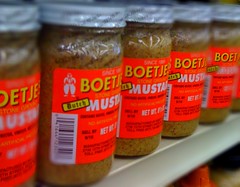At Anna’s bon voyage party last week we engaged in a little discussion about one of the culinary bright spots in the Quad Cities: Boetje’s mustard. Boetje’s mustard is revered by the locals, and at a party in the Quad Cities one criticizes this golden paste at one’s peril. I made the mistake of showing a slight discontent when the only mustard available at the party was Boetje’s. My brother, Jon (whom I love with a deep affection, well beyond the kind of filial obligation one shows one’s kin), chuckled and told one of the party guests that “Mark doesn’t think Boetje’s is that great.”
I had told Jon a few days earlier that there are some other mustards I prefer to Boetje’s. I know his response was meant in jest, but he gave me grief for criticizing the local favorite. I must go on record, right now, and say: Boetje’s mustard is a very tasty mustard. It’s pretty much a straight up mustard, too. No fancy ingredients or additional flavor layers — all it contains is water, vinegar, mustard seed, sugar and salt. If I’m choosing between Boetje’s and French’s, there’s really no question that Boetje’s is a superior product. Even when choosing between Boetje’s and a Dijon mustard like Grey Poupon, Boetje’s often gets the nod. There are times, though, when a more complex mustard is called for. And at those times I find myself yearning for one of the mustards we tasted when visiting the Mustard Museum in Mount Horeb, Wisconsin, a while back. On our way to Madison for a weekend honeymoon last fall, Anna and I stopped in at the Museum and tasted mustard for about an hour. Among my favorites were the whole grain mustards in which the mustard seeds are not crushed at all. Eating a bite of such a mustard is a little like tasting caviar. The flavor is released as you crush the seeds in your mouth. Try a little whole grain mustard on a slice of dried italian salami. Heaven on your tongue! If you ever find yourself driving on Highway 151 from Dubuque, Iowa, to Madison, Wisconsin, you absolutely must get off the road at Mt. Horeb and sample some mustard.
One reason I’m looking forward to moving back to Oakland is the fine farmers’ market that’s just a few blocks from our new apartment. Mustard is a culinary staple, and I’m looking forward to tasting some locally made mustards. According to local lore, mustard was first introduced in California by Father Junipero Serra. Thanks be to him for bringing this prolific and tasty weed to the Golden State!

